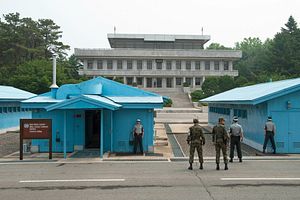North Korea’s recent testing of an alleged hydrogen bomb followed by the launching of a rocket that put a satellite into space has many officials in Washington and Seoul puzzled over what the brash new North Korean leader, Kim Jong-un, hopes to achieve.
While most analysts view North Korea’s provocations as a kind of familiar madness reminiscent of the sable-rattling that Kim’s father and his grandfather indulged in, the drumbeat of increasingly bellicose threats seems to have gotten out of hand.
This has led some analysts to ponder whether Kim Jong-un really understands the rules of the game, at least the way his father and grandfather played it, and whether his blustering rhetoric and provocative actions might result in a misstep that could in turn lead to a war in Asia.
Yet, as shocking as Pyongyang’s blitz of threats may seem to Americans, they are actually quite ordinary to North Koreans. North Korean propaganda regularly features North Korean missiles blowing up the White House and North Korean workers sputtering vitriol against the United States and South Korea. What is new about Pyongyang’s recent bellicosity is not that it signals a change in the North Korean military posture and attitude but that Pyongyang has decided to showcase its domestic vitriol and threats for international consumption.
One reason for this decision may have to do with the changing nature of the South Korean electorate. In the past, Pyongyang tended to temper its heated rhetoric due to the existence of a fairly large and influential segment of the South Korean population, made up mostly of students and intellectuals, who harbored sympathetic feelings toward the North. The lush “Sunshine years” that began with Kim Dae-jung’s presidency in 1998 provided North Korea with abundant aid and investments. Kim’s successor, Roh Moo-hyun, continued Kim’s “engagement policy” of unconditional aid and support. Roh was also part of a generation of progressive leaders who came of age in the 1980s and idealized North Korea while often denigrating South Korea’s past military leaders who were deemed as lackeys of American “imperialists.”
But the collapse of North Korea’s economy in the 1990s and the failure of the Sunshine policy turned many ordinary South Koreans, even those who once supported their country’s engagement policy, firmly against the North. The election of Park Geun-hye in 2013, coming after the hardline presidency of Lee Myong-bak, merely reconfirmed this change of heart.
But this year’s ongoing North Korean crisis has some South Korean lawmakers wondering whether Park’s hardline policy may actually push North Korea to the brink of war, or collapse. In her nationally televised speech last week, Park defended her hardline approach, including her controversial decision to close the Kaesong Industrial Complex in North Korea, while stressing South Korean unity as the only way to frustrate North Korea’s designs. Park’s stress on preventing “South-South conflict” and maintaining national consensus in the face of Kim’s provocative actions is noteworthy. This is because North Korea’s strategy for unification has always relied on stirring up domestic friction and internal uprising in the South to weaken South Korean defenses.
Recognizing North Korea’s belligerent actions for what they really are, a desperate measure to force the Park government to adopt a more flexible policy toward the North by inciting domestic confusion and promoting internal dissention in the South, may not solve the Korean crisis but it can help to avoid any missteps that could lead to another war in Asia.
Sheila Miyoshi Jager teaches history at Oberlin College and is the author of Brothers at War: The Unending Conflict in Korea.

































